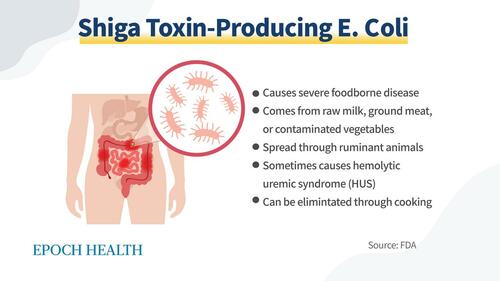The E. Coli Super-Pathogens You Should Know About
Authored by Dr. Sean Lin and Jacky Guan via The Epoch Times (emphasis ours),
Foodborne illnesses, also known as food poisoning, are a serious public health issue. Each year, they make 48 million people get sick, hospitalize 128,000, and cause the death of 3,000. Pathogenic E. coli is one of the most common known foodborne pathogens. However, the severity of various E. coli strains varies tremendously and the public should be cautious about one particularly dangerous type of E. coli.
E. Coli 101
Escherichia coli, also known as E. coli, is one of the most common types of bacteria known to mankind. From helping with digestion in your stomach to being a producer of artificial insulin, the bacteria discovered in 1885 have been studied countless times and improved our understanding of the microscopic world.
The E. coli we infamously know from the news belong to the group Enteropathogenic E. coli (EPEC) and are pathogens responsible for food poisoning. Foodborne illnesses also include Salmonella and Norovirus (responsible for the recent cruise ship outbreaks). Typically, an E. coli infection occurs when a person comes into contact with contaminated food, animals, or water. It usually only causes mild abdominal pain or brief diarrhea. Other symptoms include stomach cramps, nausea, vomiting, and fever.
Typical treatment usually involves rest, hydration, and nutritional support. The disease is usually self-limiting as the body can normally clear it. The use of antibiotics is common in treating E. coli, yet antibiotic resistance is also a problem worldwide. However, severe forms of E. coli are the Shiga toxin-producing variants of the bacteria that can have dire consequences.
STEC Variants Severely Damage Intestinal Linings and Kidneys
The variants of E. coli that produce Shiga toxins (Stx) are called Shiga toxin-producing E. coli, or STEC. They have gained a lot of attention in the past few decades, as they are known for causing severe disease.
STEC belongs to the EPEC group. STEC strains are capable of producing toxins named Shiga toxin type 1 (Stx1), type 2 (Stx2), or both, encoded by stx1 and stx2 genes, respectively.
The toxins are named after Kiyoshi Shiga, who first described the bacterial origin of dysentery caused by Shigella dysenteriae. Historically, the toxin produced by E. coli was named Shiga-like toxin (SLT). Now, Shigella dysenteriae and STEC are regarded as the most common sources of Shiga toxins.
Symptoms of a STEC infection include abdominal pain and watery diarrhea. There are also severe—possibly life-threatening—cases characterized by hemorrhagic colitis. These types of E. coli are also called Enterohemorrhagic E. coli (EHEC). Shiga toxins are also associated with hemolytic uremic syndrome (HUS).
In particular, the STEC O157:H7 and STEC O104:H4 are the two most notorious STEC strains. One could say these STEC groups are something like super soldiers in the E. coli army.

The Shiga toxin does most of its work in small blood vessels, as it is rather ineffective in large vessels such as major veins and arteries. This is how the toxin can specialize against the digestive tract, kidney, and lungs. For example, the Shiga toxins are good at destroying clusters of nerve endings or small blood vessels in the kidneys, which can lead to kidney failure and even HUS. It can severely damage the lungs as well, so food poisoning associated with Shiga toxins is often also associated with lung and nervous system damage.
Read more here...
https://ift.tt/7qQDWhM
from ZeroHedge News https://ift.tt/7qQDWhM
via IFTTT





0 comments
Post a Comment